How To Wear an Elizabethan Coif
Laura Mellin, October 2004
|
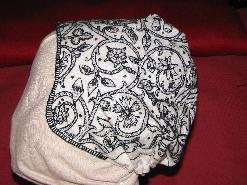 |
| A reproduction of a 16th C. coif |
|
The basic Elizabethan (16th-early 17th Century) coif pattern is pretty simple, but there are differing opinions on how the coif was worn. Thanks to the practice of "Living History" (also known as "Experimental Archaeology"), it is possible to determine fit and function using modern reproductions of period clothing. This concept has been invaluable in developing my theories on Elizabethan head coverings. Reproduction coifs have a tendency to slip off the head unless secured with a hat or pins; I have heard numerous complaints from re-enactors and the museum staff at Jamestown Settlement Museum about coifs falling off, and have had the same experience when wearing my coif loose without a hat or pins. From an interpretive perspective, it does not make sense that a working garment would be so difficult to wear. Certainly you cannot get much done if you are attending to a slipping coif all day. Some costumers solve the problem by sewing the coif in two pieces so that it fits closely to the head (some even add elastic or a hair comb), but the archaeological evidence does not support a coif made with a separate brim (and certainly not elastic).1 The only way to get the period coif to stay in place currently is to wear a hat to hold it in place. Since 16th Century pictures often show women wearing the coif without any kind of hat, it seems we are still missing a piece of the puzzle. A coif that needs constant adjustment just to make it stay on is impractical; since it was worn by working women, there had to be something in the way it was worn that made it stay in place.
A caveat: The single most important thing to remember about costume theory is that nothing was ever done only one way. The coifs, veils and cauls of the nobility were custom made, and no two are alike. While the same can be said for working women (since coifs were often made by the wearer, and all were hand-made), the more elaborate a noblewoman's head covering is, the more likely it is to be absolutely unique, and a poor example from which to draw conclusions about the majority of coifs worn by the nobility or the working classes. The coif theory detailed here applies to the everyday linen coif worn by working women - the most commonly depicted type of head covering.
|
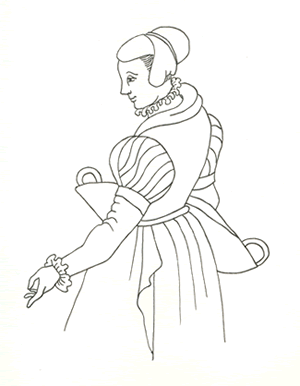 |
| Coif with forehead cloth underneath; Civitates Orbis Terrarium |
|
Surviving Elizabethan coifs are very simple; made in one piece and tied with a drawstring.2 The coif of this period is the one with the slipping problem. The most popular current method used to prevent slipping is to ignore the existing 16th Century pieces and interpret contemporary woodcuts in a way that assumes the coif was made in two pieces: The crown is cut as a large circle of cloth which is then pleated into the brim, which is cut to resemble the shape visible in pictures of 16th Century women. This theory was developed by applying modern costume technique to a 16th Century garment, and fails to account for the lack of surviving two-piece coifs. Period depictions show a head piece that could appear to modern eyes to be made with a brim; movie costumers have used this type of pattern for almost 100 years. Unfortunately, while the brim helps the coif stay on, this pattern is a Victorian interpretation of Elizabethan dress, and bears little relation to the surviving 16th Century coifs. Many people reproducing period clothing use modern sewing and patterning methods without really understanding the construction of period examples. This is a mistake that is most obvious in the movies, but can be found in any venue where period clothing is reconstructed.
Despite the popularity of the current pattern, it fails to account for a couple of important facts. Contemporary paintings show almost every woman in some kind of coif, so they must have been very common. There are no existing two-piece coifs from the 16th Century, but there are lots of one-piece coifs ("hundreds", according to the pre-17th Century Textiles Curator at the Victoria and Albert Museum in London).3 This raises the question: If coifs were so common, and we have so many surviving one-piece examples, why are we making two-piece pattern coifs? One reason is that the one-piece coifs are hard to wear; they slip off and need constant adjustment. Because the pictures have been interpreted with modern eyes, the two-piece pattern was created, despite the contradictory surviving evidence. The other piece that sometimes is paired with the extant coifs is a triangular cloth (called a forehead cloth)4, but has been put aside as unimportant, and is not commonly used by re-enactors. In my research, I've come to realize the forehead cloth is very important, and I hope to show how it applies to correct interpretation of 16th Century pictures.
|
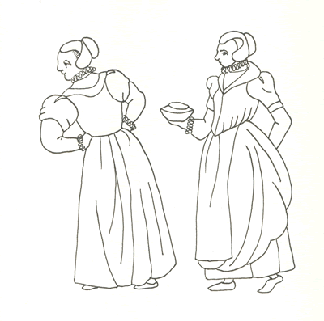 |
| Two women in coifs and forehead cloths; Tittle Tattle (broadside) |
|
So here is our problem: The pictures show a coif that looks like it was made in two or even three pieces, but the only surviving examples we have are one piece. We also have surviving forehead cloths. How does this all fit together?
Three artworks from the 16th Century answer this question. "A Fete at Bermondsey" (1574-6) by Georges Hoefnagel,5 "Tittle Tattle" (1603),6 a broadsheet on the evils of gossip, and the "Civitates Orbis Terrarum" (1573).7 While these are far from the only pictures that show coifs (the coif shows up in Dutch paintings until the late 1600s),8 these particular pictures show the coifs very clearly. More importantly, they show women at work wearing their everyday clothes, and the coif as a working head covering. Close examination of these pictures led me to the theory that the forehead cloth and the coif were commonly worn together and the coif drawstrings tied around the head in such a way that it appears to have a separate brim, but actually does not.
After study of the period pictures and experimentation with a reproduction coif and forehead cloth, I am convinced that to achieve the brimmed coif look, the hair is pinned into a large bun at the crown of the head, then the forehead cloth is tied on, sometimes with the flat side forward, sometimes with the point forward9. The coif is then put on over the cloth. The drawstring of the coif is pulled tight at the nape of the neck, then tied around the bun to hold everything in place. The length of the drawstrings on some surviving coifs supports this tying method; many coifs, such as those in the DeWitt Wallace Museum in Williamsburg and the Victoria & Albert Museum in London, have drawstrings that are much longer than necessary for simply tying at the nape of the neck, longer even than necessary for tying the coif under the chin.10 However, when tied around a bun, the length seems about right. Experiments with reproduction coifs bear out the need for a drawstring the length of the longer ones in the V&A (about a yard and a half of drawstring).
|
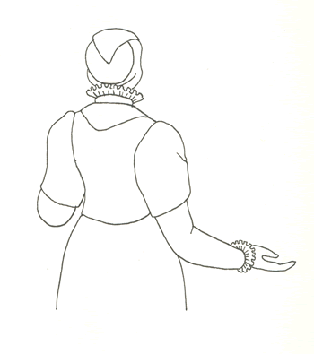 |
| A woman in a coif with forehead cloth worn over it; A Fete at Bermondsey, Hoefnagel, 1575 |
|
Further support can be found in the paintings of Dutch women from the 16th and 17th Centuries. There are more paintings of the Dutch middle class than the English middle class; the vogue for depicting everyday life in hyperrealistic fashion did not catch on in England for another century and a half, so we are limited to only a few English sources. However, Holland had many social and commercial ties to England in the Elizabethan era, and combining all Dutch and English pictorial evidence shows distinct parallels in dress between the two countries, including coifs. Many Dutch paintings show the coif very clearly,11 plus the hairstyle underneath the coif that allows the coif to be tied in place (Mid-17th Century paintings clearly show the drawstrings of the coif tied around the bun; though they no longer wear the forehead cloth and are out of period for the SCA, the shape of the coif is very much the same as the earlier paintings and drawings, just smaller). The pre-17th Century pictures are more mannerist than realistic, so the ties on the coif are not as clearly shown as in the later paintings, but the shape of the coif is the same, and in repeated over and over again in everything from full paintings to crude woodcuts.
Documenting the everyday use of the forehead cloth was the real breakthrough for me. Other construction methods have been attempted to explain the extra fabric in 16th Century pictures, but no two-piece pattern can correctly reproduce the look. Many of the pictures show a front piece to the coif that cannot be created either by tying the coif in the period manner or by putting a brim and crown together in the modern method12. This rogue piece of fabric is the forehead cloth. Since it is mostly worn under the coif, it cannot be seen in its entirety. The forehead cloth appears routinely in Elizabethan pictures, but because of a misinterpreted quote by Fynes Moryson in 1617,13 the significance of the forehead cloth has been ignored by re-enactors and museums alike. The current explanation of the use of the forehead cloth is based on the Moryson quote:
"Many weare such cross-clothes or forehead clothes as our women use when they are sick."14
This has been commonly interpreted to mean that forehead cloths were only worn during illness, but if the sentence is read slightly differently, it means something else entirely. Moryson is a visitor to London; he was born in Lincolnshire, and traveled extensively through Europe and Asia. In his later years, he wrote about his travels; he called the book his "Itinerarie". The key part of the quote is "Many weare…", not "…such as our women use when they are sick". I believe Moryson is talking about working women in London compared to the women he saw at home; the constant appearance of the forehead cloth in pictures argues against their use only for sick women, and the reproduction experiments show that the cloth adds much needed coverage and stability to the tied coif. The interpretation of the forehead cloths has been hampered by the fact that not as many forehead cloths survive; if worn under the coif, they would quickly become soiled, and it is likely that they were discarded and replaced more often than the coif. The fact that there is little mention of them in contemporary writings does not mean that they were not worn; their appearance in so many pictures refutes that. It merely illustrates their unimportance by virtue of their everyday use. Unless the forehead cloths were embroidered, they would have no value, and they were not embroidered much; a forehead cloth is a working-class garment, and everyday coifs and cloths were not embroidered. Embroidered coifs were worn by higher-class women, and such women would not want to associate themselves with the working classes by wearing a forehead cloth. Rich women wore their coifs tied in the same manner, but rather than cover the fronts of their heads, they developed elaborate curled and padded hairstyles to show off their status15. The few examples of embroidered forehead cloths that survive were probably given as gifts to pregnant women for wear while they were in labor.16
|
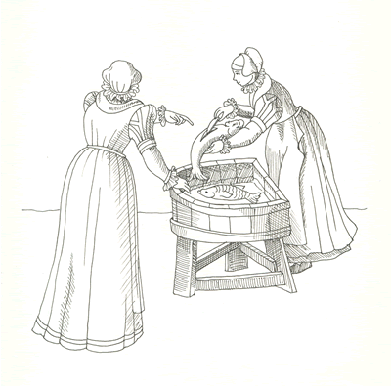 |
| The coif worn tied and untied; from the Civitates Orbis Terrarium |
|
Again, it is important to note that while simple coifs would be similar to each other, there were differences in execution from one coif to the next. Though tying seems to be the most common method, the coif is not always tied; the "Civitatis Orbis Terrarum" shows at least one woman with a loose coif with large open sides, probably created by wiring the front edge. I have found that if the coif is wired and the hair is worn in padded rolls in front, the coif does stay in place, but not nearly as securely as when tied. It also requires a lot more preparation of the hair, and takes longer to put on. It does not appear in pictures one tenth as often as the other style, but it is an example of how many ways there were to wear even a simple coif. Reproduction coifs, even those made by the same person, do not turn out the same way each time. The reader is cautioned not to impose rigid standardization on the coifs they create; within the parameters of 16th Century clothing technology, there are no absolutes.
|
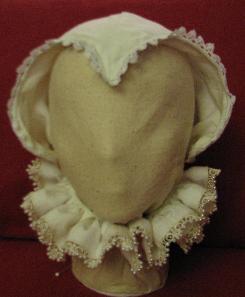 |
| wired coif - front |
|
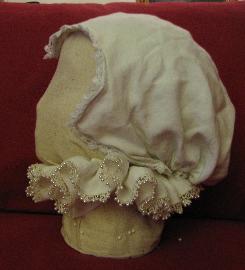 |
| wired coif - side |
|
|
How to put on the coif:
Construction note: The gathered part of the top of the coif should be sitting right where the drawstrings cross; this gives the front of the coif a nice clean look. When sewing the coif together, the top seam should be no longer than the measurement from your front hairline to the high point at the back of your head. Gather the rest of the seam into pleats.
|
First, the hair underneath the coif is braided or pinned into place; if the hair is short, a hairpiece can be used to fill out a small bun. Paintings of Dutch and English women show the hair pinned up in such a manner.17 False hairpieces are period for the 16th Century; there were certainly many wig-makers in London then, and many of the hairstyles were not possible without false hair padding. If your bun is big enough, the coif when tied will resemble the two-piece look. When tied, the string will sink in around the bun, and be harder to see, hence the appearance of a brimmed coif.
(Note: The term "bun" is used to denote hair tied, pinned, or laced into place on the back of the head in a round shape.)
|
| It also results in the front of the hair being more exposed, and this is when the triangular forehead cloth can be tied on to protect the forehead and hair from the weather. The "Fete at Bermondsey" painting shows at least one woman with the forehead cloth tied over the coif; the point of the cloth hangs down over the back of the coif.18
Once your hair is in a bun, tie on the forehead cloth if you are going to wear it, and adjust it so that it sits comfortably on your head with no wrinkles.
|
Put the coif on so that all remaining exposed hair is covered, then tighten the drawstrings so that the base of the coif is snugly gathered at the nape of the neck.
|
Take the drawstrings and wind them across each other around the bun, and pull tight so that there is no slack in the loop. Tie the drawstring at the nape of the neck, and tuck the ends into the coif.
|
Notes:
1. Susan North, curator of 17th and 18th century fashion, The Victoria and Albert Museum, London.
2. Examples of coifs with surviving drawstrings can be found in the V&A Museum and the DeWitt Wallace Museum, Williamsburg. British Embroidery: Curious Works from the Seventeenth Century, Kathleen Epstein, 1998, Colonial Williamsburg Foundation.
3. Susan North, V&A Museum, London.
4. Blackwork, Mary Gostelow, 1976, BT Batsford Ltd., London.
5. A Fete at Bermondsey, Georges Hoefnagel, c. 1575. Hatfield House, England.
6. Consuming Passions: Being an Historic Inquiry into Certain English Appetites, Philippa Pullar, 1970, Little, Brown and Company, Boston. The original broadsheet is in the British Museum, London.
7. The Elizabethans, Peter Brimacombe, 1999, Pitkin, London, which has an excellent reproduction of a page from the Civitates Orbis Terrarium. The detail used for this research is "The English Method of Selling Pike".
8. The Wallace Collection, London.
9. A Fete at Bermondsey.
10. Susan North, V&A Museum, London.
11. The Wallace Collection, London. The ties can clearly be seen in multiple paintings. 12. Tittle Tattle. Repeated attempts with modern construction techniques could not reproduce the look accurately.
13. An Itinerarie, Fynes Moryson, 1605-17, British Library, London.
14. Ibid.
15. The Oxford Illustrated History of Tudor and Stuart Britain, John Merrill, editor, 1996, Oxford University Press, Oxford. Panorama of the Renaissance, Margaret Aston, editor, 1996, Harry N. Abrams, Inc.
16. Susan North, V&A Museum, London. A considerable number of things were given to women for use during their "confinement"; while an elaborately embroidered coif and forehead cloth might not be worn for the actual labour, they would certainly be worn for visitors in the days after the birth.
17. The Wallace Collection, London.
18. A Fete at Bermondsey.
|
The author at Jamestown in 2002; tied coif and forehead cloth (unfortunately, I don't have enough hair to fill the coif completely, but I'm working on that).
The great thing about wearing the coif like this is that it didn't move or slip all day, despite cooking over an open fire and picking vegetables in the fields. We tested it in several ways, and even when I held my head upside down and shook it, the coif stayed in place and needed no fixing.
Below, Jamestown 2006; front and side.
|
|